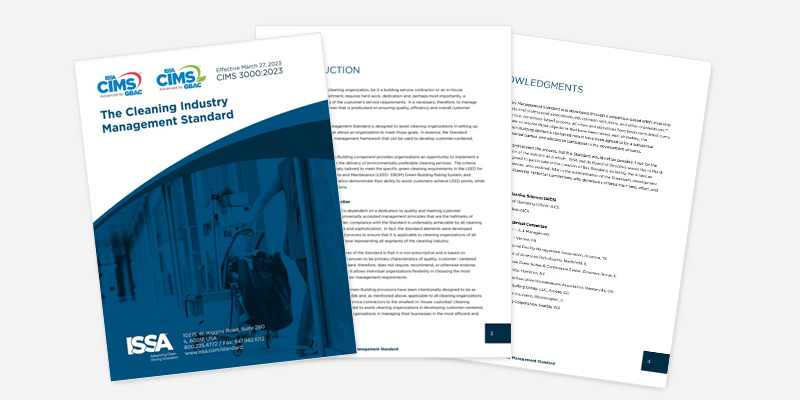Science Concepts for Effective Cleaning

Science is a formally accepted and recognized body of knowledge that answers the question, “How?” Science explains how the world around us is structured and how it functions.
Cleaning, maintenance, and restoration are environmental management processes. To be fully effective, these processes must be based on science concepts, particularly environmental science concepts.
Science basics
Humans learn from the environment. Our sciences come from our observation, study, and use of the physical, chemical, and biological world surrounding us.
The “basic sciences” have their origins in the discipline known as “natural philosophy,” which is the logical and systematic examination of the natural and man-made world. Through the long-term examination of nature, there have evolved fundamental concepts we use to make decisions related to how we live in relation to natural processes.
Scientific knowledge is derived from the scientific method. The scientific method is a process known as “hypothesis testing.” It is an analytical procedure in which we conjecture possibilities (hypothesize), design, and execute an experiment to test the hypothesis, make observations, measure conditions, collect and analyze data, and draw conclusions whereby we accept or reject the hypothesis.
We refer to the scientific method as “research.” Research is the process of guided learning. The scientific method forces us to go beyond personal opinion and political correctness. Through the scientific method, we discover and demonstrate facts:
- Science always requires that we show the data.
- Science has limitations.
- Science is a body of knowledge that is constantly changing and growing.
- Science is the only discipline that opens itself to disproof.
Environmental science
Environmental science is a robust body of knowledge that brings all the basic sciences into one arena where we use them to take a broad view of the world around us and better explain how complex environmental systems work.
One cannot manage what one does not understand. Science explains how the environment works. Without a basic understanding of environmental science, we cannot effectively manage the environment—natural or built. Here are some useful reasons why you should know the basic environmental science concepts and methods:
- Environmental science is the basis for informed judgments and sensible decisions that help us maintain a sustainable society.
- Environmental science uses all the basic sciences to look at the world broadly.
- Environmental science forces us to use systems-thinking to realize that all conditions around us are connected.
- Environmental science helps us better understand the essential conditions for a healthy human existence.
In environmental science, we examine matter and energy flowing in and between the compartments that make up the environmental system. We identify and study the life-affecting processes these flows create. Particular attention is given to the affect humans have on these natural processes and the influences these processes have on human wellbeing.
Environment defined and described
To understand the environments we build, we first must define “environment” and then describe “environmental system,” at least on a general level. We need to pay particular attention to how matter and energy flow in and out of “environmental compartments” and how that flow affects human existence.
An environment constitutes all the surrounding, interacting conditions essential for human existence and that of all living creatures. Environment is the totality of all the constantly changing surrounding biotic and abiotic conditions that affect the life of an organism.
Biotic conditions are life forms; viruses (for the purposes of this article), bacteria, fungi, animals, and plants are life forms. Movement, organization, constant conditions within the body, energy use, reproduction, and growth characterize “life.” Abiotic conditions are nonliving. In the natural environmental system, we know these to include chemicals, rocks, water, air, and sunlight.
The natural environmental system is represented as interconnected compartments: The lithosphere, atmosphere, hydrosphere, and biosphere. The lithosphere is made up of land, sediments, and rocks.
The atmosphere is a mixture of gases, largely oxygen and nitrogen, held to Earth by gravity. The hydrosphere is the watery gaseous envelope surrounding Earth and the liquid water reservoir in and on Earth’s surface. The biosphere is the living and dead organic components of the planet.
All of these, along with their subcompartments, intersect and interact with each other. One of these subcompartments is the built environment.
Ecosystems and the built environment
Ecology and environmental systems are subjects we usually associate with understanding the functioning of natural systems. The prefix “eco” is derived from a Greek word meaning “home.” Taken literally, ecology means the study of homes.
Ecosystems are home systems. Earth, with all its many subcompartments, is home to all life forms. Our most immediate environment—our human home—can also be thought of as an ecosystem. The built habitat is governed by many of the same environmental-management and science concepts and principles as the other subcompartments of natural systems.
A habitat is the place where a particular organism lives and grows. How an organism interacts with its habitat is its niche. A niche constitutes the total set of conditions that support an organism’s life and thus makes possible a healthy habitat.
The human habitat is a subcompartment of the natural environmental system. The science concepts we use to explain how the processes of the natural environment function are germane to the built human habitat.
Life-supporting environments have both living and nonliving components that interact with each other. When communities of organisms interact with each other, as well as with their nonliving chemical and physical environment, in a balanced way to sustain life, they create an “ecosystem.”
Every organism must adapt to both the biotic and abiotic conditions, or they cannot live in that space. Change in even a single factor can cause the breakdown of the life-support system. When the life-sustaining conditions of a habitat are expended or significantly altered, the organisms residing within are severely stressed, become dormant, die, or move on to another home.
For every ecosystem, life-supporting conditions are found within an optimal range. When the optimal range is exceeded, the species is put in an unhealthy state. If stressed too much, the species dies. Cleaning, the management of unwanted matter, reduces stress.
Many of the organisms we confront in cleaning are decomposers. Their basic role is to move carbon through its natural cycle. This knowledge helps us manage more effectively. For example, subcompartments composed of wet organic matter support fungi and bacteria more readily than others. These living organisms have an absolute requirement for water. We would, therefore, expect to find mold on wet paper rather than on the surface of a clean, dry glass window.
If we wish to control these living forms of unwanted matter, we can alter their environment by removing (cleaning away) the water or organic (carbon-based) food supply.
Matter defined and described
Matter describes anything of substance. Matter is mass-energy that moves with velocities less than the speed of light. Matter has mass attracted by the force of gravity.
Substances can be living or nonliving. Substances are of three forms: Solids, liquids, and gases. The various substances we find moving around an environmental system have different shapes, sizes, and chemical compositions, densities, absorption, adsorption, and adhesion characteristics. Heterogeneous mixtures of solid substances (particles) that can be suspended in air are called dusts.
Matter is constantly in motion to some extent. Matter can be measured and described quantitatively.
Loading is the quantity of matter or energy that is introduced or discharged into a system or compartment. We often use the terms “organic loading,” “dust loading,” or “gas loading.” Units describe these. A unit is a measuring rod used to characterize a particulate measurement. For example, we use the standard unit “grams” to characterize or describe an amount of matter.
Quantity is the actual number obtained using the measuring rod. A gram (gm) of matter is the weight of a cubic centimeter of water or the weight of about a thimble full of water. A microgram (ug) is a millionth of a gram. A nanogram (ng) is a billionth of a gram.
Quantification is essential for assessing cleaning effectiveness. For example, if dust in a carpet exceeds 2 gm per square meter (2gm/m2), it is generally considered in unsanitary condition. On the other hand, dusts in a range of 0 to 15 ug per cubic meter (0–15ug/m3) of air suggest an acceptable or sanitary environment.
Energy and force
Energy is a requirement for cleaning. Energy is the capacity to move matter (a substance with mass) a known distance. Thus, energy is the capacity to do work.
- There are different types of energy:
- “Potential energy” is matter in position that is ready to move.
- “Gravitational energy” is the attraction of two objects with known mass and distance apart.
- “Kinetic energy” is matter in motion with a known mass and velocity.
- “Heat energy” is the sum of kinetic energies in which many masses move randomly in all directions.
Matter is put in motion through the application of force. The displacement of matter from a compartment or environment is often brought about through mechanical force. Common forms in cleaning include wiping or brushing, as well as water flow or air flow.
Laws of matter and energy
There are two fundamental laws of matter and energy.
The first law states that matter and energy are not destroyed, but rather remain constant. Matter and energy move around: Matter goes to energy, and energy goes to matter.
The second law states that all organized systems seek their most disorganized state. This is known as “entropy.” Entropy helps explain why humans will always need effective cleaning.
Entropy is a measure of how much a system has become disordered. The more activity we have, the more entropy we have. The more objects and activities we have in a space, the more complexity we have and the more disorder we have.
This is also called the “Law of Requisite Variety.” In mathematical terms, entropy can be expressed as a formula: E = n log n, where n is the number of things or events in a space.
What this mathematical model describes is the following: If we have no activity or no elements in an environment, we have no disorder. If we have only one activity or element in an environmental space, there is no interaction and no disorder. When we have two or three activities going on in an environment, interactions occur, and we create disorder. If we have 50 things going on in the same environment, we have high disorder. This higher disorder is multiplied far beyond direct proportion as the number of events and activities grow.
The more objects and activities we have in a space, the more complexity and disorder we have, and, therefore, the more cleaning we need. The amount of unwanted matter that builds up in an environment is mainly a function of an activity level and the size of the compartment. The more objects and activities we have at work in a space, the more unwanted matter we generate and the more cleaning we need.
Effective cleaning of a defined space with a known activity level and an intended use requires a sufficient amount of energy to move matter. In cleaning, sufficient energy is indicated by money, labor, and technology. Simply allocating cleaning resources and time as a function of space alone, without considering the activity level, intended use of the environment, and its need for a specific level of sanitation, will not produce effective cleaning.
The importance of time
Time is a critical element of different cleaning methods. In cleaning:
- We locate and identify the pollutant.
- We capture it by breaking it down chemically or mechanically.
- We contain it on a surface or suspend it in an air or liquid fluid.
- We remove the surface or fluid.
- Finally, we dispose of the pollutant.
Obviously, so many steps take time. Less obviously, each step takes time. If adequate time is not allocated to any one of these steps, cleaning will not be as effective as it could be. As an example, we might apply a solvent to break down grease. If we simply apply a solvent and then wipe it off, there will not have been ample time for a chemical reaction.
Connected compartments
Cleaning is applied to environmental compartments or subcompartments. A compartment or subcompartment is simply a space that contains matter and energy.
All objects in the built environment are subcompartments of that environment as well as the natural environment. Major subcompartments of the indoor environment include flooring; the indoor atmosphere; elevated surfaces such as walls, shelves, furniture, and ceilings; and heating, ventilation, air conditioning (HVAC) systems. Any object or place found within these subcompartments is also a subcompartment.
Understanding an environment allows us to know the natural tendencies so that we can be most effective at removing or repositioning matter. Depending on how effectively each of these compartments is cleaned, they either achieve their intended purpose or create unintended environmental conditions or hazards. Because matter and energy are constantly in motion, compartments are connected and influence each other in terms of transferring matter. Depending on the compartmental matter load and environmental conditions, such as convection and natural ventilation, unwanted matter is continuously transferred from one compartment to another.
Open and closed systems
Pollution constantly builds up and interferes with every human endeavor. Cleaning is always necessary to keep matter at a sanitary level in these closed built environments.
In an open environmental system, matter or energy may be lost or gained, often through movement between the insides and outsides of the system, or due to processes of creation or destruction within the system. Carpet is an open system, and matter and energy are always crossing its boundaries.
In a closed environmental system, matter is kept within the system; matter moves between the compartments of the system. In order to conserve energy, modern buildings tend to be closed systems. Matter tends to build up and reaches a steady-state condition when it is in a closed compartment. The quantity of matter in a system depends on surrounding emitting sources and human activity levels.
Feedback
Positive feedback causes the matter and energy change in a system to escalate. Negative feedback causes the change in a system to bring about the original state. When a system reaches equilibrium, the amount of matter in each compartment stabilizes–ceasing to change in time. The reason is that the rate in equals the rate out.
For steady state, the rate of matter in plus the rate of creation of matter inside the compartment equals the rate out plus the rate of destruction inside the compartment. Scheduled cleaning will produce a steady state condition indoors.
Article reprinted with permission from Cleaning Science Publishing LLC

















